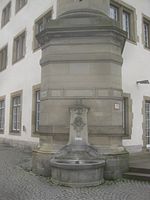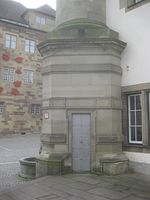Mercury column (Stuttgart)
The Mercury Column is a former water tower in Stuttgart, which was built in 1598 according to plans by Heinrich Schickhardt and has been crowned by a gold-plated statue of Mercury since 1862 . The tower is connected to the northeast corner of the Old Chancellery , a building between Schillerplatz and Schlossplatz . The corner tower is designed as an Ionic column and has a capital decorated with rich ornaments based on a design by Wendel Dietterlin, above which a grid-protected viewing platform is attached. The column ends in a stump with a hemisphere that a "floating Mercury" touches with one foot.
The Cossack fountain, designed as a wall or tub fountain, leans against the massive pedestal of the column .
The column used to be called the Doric water column (although it has an Ionic capital), and is now sometimes also referred to as the water tower or the old water tower .
description
The Mercury Column in Stuttgart stands diagonally opposite the northwest entrance of the Old Castle on a line between the collegiate church and the anniversary column . It is connected to the north-east corner of the old chancellery , the ridge of which extends to the height of the observation platform of the Mercury column.
pedestal
The column rests on a five meter high and 2.5 meter wide pedestal with a square floor plan and bevelled corners. The pedestal body, structured by three circumferential bands, rises above a low plinth and ends with a protruding cornice . At the front of the pedestal is leaning Kosakenbrünnele , and on the right side of the wooden door leading into the interior of the column, which is, however, not released to the public.
pillar
The colossal, over 20 meter high column (without a statue), which was built according to a design by Heinrich Schickhardt , shows the entasis (swelling) of a classic column, is made of stone and provided with slot-like openings in five vertically superimposed positions. Inside the column there is a spiral staircase that you can use to climb to the viewing platform.
The Ionic capital designed by Wendel Dietterlin with the typical volutes at the corners is decorated with fittings- like ornaments (mainly French lilies ) according to the taste of the Renaissance . It ends with two square plates, an echinus- like intermediate plate , to which the protective grids were previously attached (the fastening holes can still be seen), and a cover plate ( abacus ) that supports the viewing platform.
platform
The viewing platform was originally protected by an ornate, wrought-iron grille, which was decorated with rich ornaments and angels with outspread wings. Today the platform is surrounded by a simple bar grating with a decorative ball at the four corners. A cylindrical stump about three meters high rises from the platform as the end of the column, around which a rosette ribbon loops halfway up . The stump of the column ends like a capital with a protruding, console-supported plate, which is covered with leaf ornaments all around, and is crowned by a fluted, pumpkin-like hemisphere on which the "floating Mercury" places his left foot.
Mercury
In 1862 the water box that had crowned the old water tower was replaced by the approximately three meter high figure of the "Floating Mercury ". The naked messenger of the gods from Greco-Roman mythology has a strong, athletic figure, the pronounced calf and gluteal muscles show him as an experienced runner, who does his divine mission all the better with his winged feet and a winged helmet. With his left foot, on which the whole body weight rests, the "youth in gold" touches the fluted hemisphere that closes the column stump above the capital.
The other limbs of the messenger of the gods rushing forward swing in apparent weightlessness through the air: the drawn, half-angled right leg, the downward stretched left, proudly holding up the rod of Mercury , the symbol of his divine mission, and the upraised right arm with the Pointing finger in the sky to his “divine client” above him. The index finger is followed by the gaze of the beautiful, high-turned head, which is framed by a ring of curls protruding from under the helmet.
Mercury by Giovanni Bologna in the Louvre
The sculpture was originally copied by Ludwig von Hofer , court sculptor of the Württemberg King Wilhelm I , after a bronze Mercury by Giovanni Bologna from 1580. Bologna's sculpture captivates and a. through the artful, helically wound representation of the body, a stylistic feature of Mannerism , whose basic pattern, the Figura serpentinata (screw figure ), goes back to the pre-Christian Laocoon group and was used in the Renaissance a . a. was also taken up again by Leonardo da Vinci , Raffael and Michelangelo .
Hofer's Mercury differs from its original in two striking features:
- His Mercury prances on a hemisphere, while Bologna's statue balances on a column of air that shoots up from the mouth of the wind god Zephyr , underlining the figure's light-footed levitation. Hofer may have omitted this detail because the zephyr's head would hardly be noticed from the frog's perspective of the passing viewer anyway.
- Hofer replaced the intense surface gloss of the original with the gilding of the figure, whose radiance also reaches the distant observer.
The original cast zinc statue was replaced by a gold-plated bronze cast by the Strassacker art foundry in Süssen after it was damaged in World War II.
Kosakenbrünnele
The Kosakenbrünnele is a wall fountain that leans with its back wall against the front of the Mercury column. The fountain was carved out of sandstone and is about 2.5 meters high and 1.7 meters wide. The wall section of the fountain is made as a stele . It rests on a widened base with flanking volutes that roll inward around rosettes . The end of the stele is formed by a broken gable crowned by a shell , the two curved, volute-like halves of which also roll around two rosettes from which fish and other marine animals hang down.
The head of a girl in the center of the stele, surrounded by shells, fittings and scrollwork, wears a richly decorated diadem and a pearl necklace around his neck and feeds the semicircular well tub with water from his mouth.
According to a legend, the fountain was given the name Kosakenbrünnele because Cossacks billeted in Stuttgart used to water their horses there during the Russian-German campaign against Napoleon in 1814. Originally the fountain was attached to the right of the column and was moved after the installation of the Mercury statue and connected to the Mercury column.
history
"To feed the waterworks in the Lustgarten and the fountain in the Old Castle , Duke Friedrich had a water tower built at the northeast corner of the Old Chancellery in 1598 [by Heinrich Schickhardt (column) and Wendel Dietterlin (capital)] ." The tower was made of a water box crowned above the capital of the so-called "Doric column" and ended with an elegant roof that tapers into a slender lantern .
In the course of the renovation of the Old Chancellery from 1861–1864, King Wilhelm I wanted the now superfluous water box to be removed from the water tower and replaced by a copy of Mercury by Giovanni Bologna . The court sculptor Ludwig von Hofer created the model, which was cast in zinc by Wilhelm Pelargus . Hofer's Merkur was severely damaged in World War II and was replaced by an aluminum casting after the war. Due to severe corrosion, this copy had to be replaced with a more durable version in 1995. The Strassacker art foundry in Süssen then created a gilded bronze cast copy based on the remains of the original statue stored in the old castle.
literature
- Uwe Bogen: Mercury's new infusion. In September the messenger of the gods “flies” back onto its pillar . In: Stuttgarter Nachrichten No. 199 of August 29, 1995, page 15 (restoration 1995).
- Eugen Dolmetsch: From the past days of Stuttgart (second volume of “Pictures from Old Stuttgart”). Self-experienced and retold. Stuttgart 1931, pages 26-28.
- Hartmut Ellrich: The historic Stuttgart. Telling pictures , Petersberg 2009, page 36.
- Patricia Peschel: The Stuttgart court sculptor Johann Ludwig von Hofer (1801–1887), work monograph , Stuttgart 2009, pages 261–264.
- Inge Petzold (text); Christel Danzer (photos): Water for utility and ornament. Stuttgart fountain and water features. Motives, design, history, fortunes. Stuttgart 1989, pages 30-31, 94-96.
- Götz Schultheiss: A god protects dealers and thieves at the same time. The Mercury on the Mercury column and the deer on the art building are top-class art. In: Stuttgarter Nachrichten number 198 of August 28, 2014 page 21, online: .
- Gustav Wais : Old Stuttgart buildings in the picture. 640 pictures, including 2 colored ones, with explanations of city history, architectural history and art history. Stuttgart 1951, reprint Frankfurt am Main 1977, No. 278–280.
- Gustav Wais : Old Stuttgart. The oldest buildings, views and city plans up to 1800. With city history, architectural history and art history explanations. Stuttgart 1954, page 103, plate 13.
- Gustav Wais: Stuttgart in the nineteenth century. 150 pictures with explanations of city history, architectural history and art history. Stuttgart 1955, No. 43.
- August Wintterlin : Württemberg artists in life pictures. Stuttgart 1895, page 339.
- Richard Zanker: Beloved old Stuttgart. Memories and encounters. Stuttgart 1977, page 22.
Web links
- "Kosaken-Brünnele" on the website of the city of Stuttgart .
- "Kosakenbrünnele" on the website "Brunnen und Staffeln in Stuttgart" .
Individual evidence
- ↑ #Wais 1951 , No. 279.
- ↑ #Peschel 2009 , page 261.
- ↑ On illustrations before 1862 the pedestal is missing and the column extends to the floor. The pedestal is present on a postcard from 1916. See: [1] and [2] (accessed March 2014).
- ↑ According to #Paulus 1889 , page 29, the column is 15 meters high up to the upper edge of the capital (including the pedestal).
- ↑ #Ellrich 2009 .
- ↑ #Ellrich 2009 .
- ↑ #Peschel 2009 , page 262.
- ↑ #Bogen 1995 .
- ↑ #Wais 1951 , No. 280.
- ↑ #Wais 1955 .
- ↑ #Wais 1951 , No. 279. - Wais erroneously writes “Südostecke”.
- ↑ #Peschel 2009 , pages 261–264.
Coordinates: 48 ° 46 '38.77 " N , 9 ° 10' 44.42" E


















